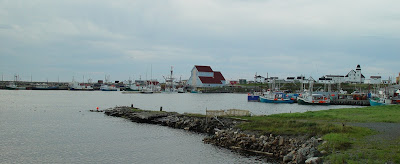Friday, August 5, 2011
Thursday, August 4, 2011
RV Celtic Explorer Venture Survey: Day 5 +
The VENTuRE Cruise: Discoveries from the Deep
On arriving at the target site there was growing excitement on board the RV Celtic Explorer for the scientists and crew. More than a year before, signs of hydrothermal vents had been detected by
Luckily the weather was now on our side, as we began to hunt for the plumes of smoky water expelled from hydrothermal vents. For this we used sensors on a CTD rig designed to measure depth, temperature, cloudiness of the water and Eh (which indicates the presence of sulphide rich water). Work began at half an hour after midnight on the 21st of July and went on day and night for the next three days. The CTD was let out to more than 2000 metres depth and regularly raised and lowered through the water column while being towed at a quarter of a knot (a procedure called Tow-Yo CTDing). In that time two ROV dives down to the bottom to check out promising signals revealed nothing.
By day three we had many plume signals but still no positive sighting of the vents themselves – this was truly becoming a frustrating search for a needle in a haystack. Normally, searching new hydrothermal vents takes several weeks, sometimes years, but we had only a few days. Finally, a strong Eh signal was followed closely by strong temperature signal, indicating a 'hot spot' close to the vent site. The fluid emitted directly from the vents is hot, roughly 350cC, instantly diffusing to 5cC a few meters from the vent as it mixes with cold seawater. The background temperature in the deep sea is about 3cC. After spending forty hours searching, we had plume signals boxed in, in record time! But the site appeared to be close to a 200m high cliff. The search would require skilled and careful ROV work.
The ROV Holland I was deployed with a full suite of cameras recording continuously in four directions. Tense with excitement, the team followed the progress of the ROV over lava flows covering the sea floor to the edge of the cliff at 2800 metres – and over and down. The day watch team on the 24th of July first spotted traces of smoke in the water at 2900 metres. Powerful lights and lasers on the ROV caught glittering sulphide particles and black soot in the water column. Soon billowing clouds of black smoke engulfed the ROV. The vent was close! News traveled throughout the ship like wildfire and the science lab was filled with scientists and crew. The ROV crept deeper and deeper 2950, 2980, 2990 metres. Suddenly, just before midnight, after more tense navigation through swirling black smoky water, crusty columnar chimneys belching black smoke emerged into view. A new vent site had been found! All hell broke loose in the science lab……
First time ever seen by human eyes, the Moytirra vent field. Picture shows chimneys of metal sulphides (black and rust coloured) at 3030m below sea level formed. They are precipitated from hot fluid erupting from the volcanic mid-Atlantic Ridge. The white mineral is anhydrite. |
Another view of the main chimney in the Moytirra vent field. This time the mid-section. This chimney by global standards is huge with an impressive girth and stands over 10m tall. Laser dots are 10cm apart.
Another view from the Moytirra vent field. "Black smoke" (volcanically heated hot vent fluid issuing from the seabed with high concentrations of metal sulphides) can be see leaking from half way up the chimney. Shrimp make a home on the vent.
The summit of the chimney with a large concentrated plume of metal sulphide enrich vent fluid issuing from the top.
A cooler less active (but still venting) chimney complex with less life.
http://scientistsatsea.blogspot.com
and UCC's student website: http://blogs.ucc.ie/wordpress/bees
And the GSI blog: http://www.infomar.ie/blog/index.php
Tuesday, July 19, 2011
RV Celtic Explorer Venture Survey: Day 4
Date: 19/07/2011
Time: 0430h (UTC)
Position: 48 deg 12.30' N 22 deg 00.36' W
Wind speed: 20 knots
We ran into rough weather on Sunday night, with the wind gusting at more than 40 knots and NOAA (the US National Oceanic and Atmospheric Administration) reporting average seven-metre swells in our area. Those conditions forced us to pause our passage and turn the ship into the weather for several hours. But although conditions were challenging for those aboard, our tying down of equipment proved secure, and we were able to resume course for the Mid-Atlantic Ridge once the seas abated.
Since then we have made steady progress in calmer seas, and expect to arrive over the Mid-Atlantic Ridge on Wednesday afternoon. Once the seas had calmed, we also held a routine emergency drill. Everyone reported to their “muster point” in response to the ship’s alarm system, and practised donning lifejackets and immersion suits.
As we get closer to the Mid-Atlantic Ridge, we’ve also been fine-tuning our procedures for collecting data and samples once we arrive. This has involved meetings and discussions with members of the team who operate the ROV, and among members of the science team who will be sharing samples. These preparations have created an air of quiet expectation in the labs aboard the ship, as the Mid-Atlantic Ridge draws nearer.
Follow our “student eye on live during the survey” at http://blogs.ucc.ie/wordpress/bees/


















